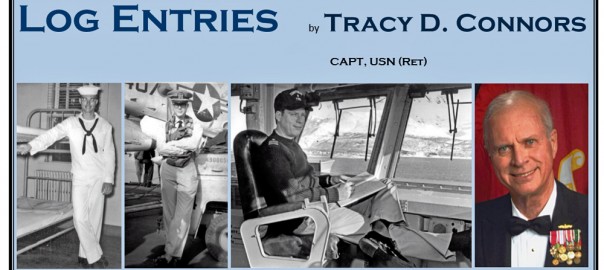Evading Soviet Trawlers
The Soviet trawlers were not only a nuisance, they were a danger to the unwary officer of the deck underway. The trawlers, actually sturdy intelligence gathering ships having no signs of nets but bristling with antennae, would attempt to maneuver their little vessel in ways that required our big carrier to maneuver to avoid either infringing on the international rules of the road, or colliding with the smaller vessel and therefore establishing the grounds for some international incident. We did our best to keep our distance and use our speed to avoid being entrapped.
The USS Roosevelt was a conventionally fueled ship. We had 12, high-pressure steam boilers that generated the power we needed for propulsion and all other services. At least two of these boilers were “down” and off-line while we were under way, to allow for cooling time, followed by regular maintenance.


During the summer months, in particular, when surface winds were light, in order to achieve speeds in excess of about 27 kn, the ship needed more than the typical eight boiler configuration, and so we brought two additional boilers online.
This gave us the extra power needed to reach up to about 30 knots. After that, all 12 boilers had to be on line, which rarely happened, e.g., during an Oppie (Operational Evaluation).
© Copyright 2017-2022 BelleAire Press
Other works by Dr. Connors…
Baited Trap, the Ambush of Mission 1890
Now Available As E-Pub

Baited Trap, The Ambush of Mission 1890 is the story of helicopter rescue Mission 1890, one of the most heroic—and costly—air rescues of the Korean War. This harrowing Air Force-Navy mission is explained in compelling detail, creating a detailed personal account of what five incredibly brave and determined Air Force and Navy airmen achieved on June 25, 1952 in the infamous “Iron Triangle.”
The Korean War’s Greatest Love Story
Baited Trap is much more than a heroic war story from the “forgotten war.” It is also the Korean War’s greatest love story, following Wayne and Della Lear, Bobby Holloway, Ron Eaton and Dolly Sharp, and Frankie and Archie Connors as they tried to put their lives and families together even as the Korean War was reaching out to engulf them.
Truckbusters From Dogpatch: the Combat Diary of the 18th Fighter-Bomber Wing in the Korean War, 1950-1953

Truckbusters from Dogpatch is the most comprehensive Korean War unit history yet prepared–over 700 pages summarizing squadron histories and first person accounts—and includes over 1,000 never before published photographs and images, highlighted by the 8 ½ x 11-inch format.
Arguably, Truckbusters From Dogpatch is the most authoritative unit history ever prepared on the Korean War. In addition to consulting formerly classified squadron histories filed monthly throughout the conflict, the author was in touch with hundreds of veterans of the 18th—pilots and ground crew—whose personal recollections add vivid detail and emotion to the facts recounted in the official documents.
Recent Log Entries by CAPT Connors…
Carrier Captain’s Night Orders: “Call Me…”
After reading these Night Orders you can better appreciate what training, attention to duty, and vigilance was required by underway watchstanders in those days. What has changed since then that has resulted in the recent tragic collisions between U.S. Navy ships and other vessels?
“We do it all!” (USS Saipan LHA-2 motto)
Saipan CO, CAPT Jack Renard, was not exaggerating when he noted that “without exception, SAIPAN is the most versatile instrument of peace or war on the seas today.” Like its motto pointed out, SAIPAN could do it all.
